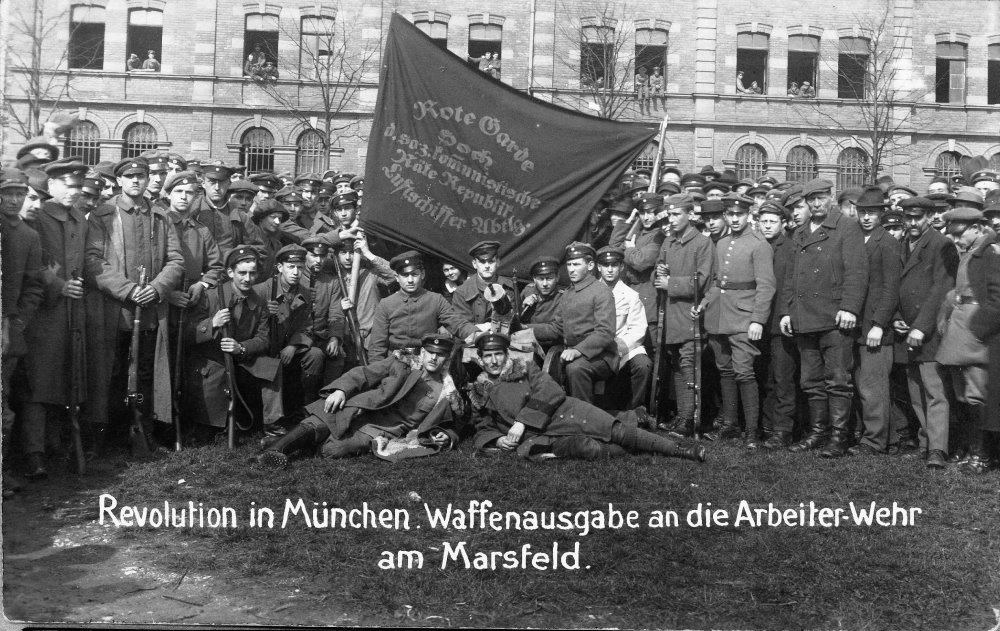
Нечто наподобие - знамя одной из организаций Коммунистической партии Германии, 1920 год. Фото из Музея Рурской области, Эссен, земля Северный Рейн - Вестфалия, ФРГ.

А это мюнхенские фрайкоры - практически единственные почему-то, кто носил белые повязки на касках. Или хотя бы белые полосы, сделанные краской.
Прикольно, что в ННА ГДР такое тоже было. Но только у военных регулировщиков. Каких совпадений не бывает.
P.S. Ну, и в довесок - про похождения фрайкоров в Латвии. А то забуду.
http://www.old.historia.lv/publikacijas/gramat/mangulis/06.nod.htm
The major Latvian counterattack began on November 3 along the seashore with artillery support from the Allied ships. On November 10 the Latvians turned southeast. They liberated the suburbs of Rīga on the west bank of Daugava on November 11 [100]. By November 16 the Latvians threatened to encircle the German headquarters at Jelgava. The fighting was bitter on both sides: prisoners were rarely taken; the Germans left behind them a scorched earth; they carried away everything portable and torched the rest[101]. Some [page 60] typical German atrocities were described by Walter Duranty, the correspondent for The New York Times[102]:
The Germans took them [four Latvian soldiers] along a road to a big field which was separated from the road by a six foot ditch. Across the field about a hundred yards away there was a wood. The Germans said to the Letts, “Now, you bastards, we’ll give you a chance. At the word of command you jump the ditch and run for your lives. We shall give you ten seconds, then start shooting.” In short, revolver practice with human targets. One Lett fell less than a dozen yards beyond the ditch with the back of his head blown off: The second was shot through the heart about twenty yards farther, and the third took a bullet in the spine a moment later, which killed him too. 1 saw the bodies of these three still lying in the snow. The fourth man was winged, but reached the shelter of the wood, and lived to tell the tale. 1 talked with him in the hospital.
The next day on my return to Rīga I heard another atrocity story. Four or five nights before, during the bombardment, the Bermondt troops had caught a Lettish spy, or a man they thought was a spy. They tied him up in barbed wire, then cut a hole in the ice on the river and dipped him through for five seconds, to make him confess. They would pull him out and a film of ice would immediately form over him. There were thirteen such films on his body when the Letts found it, so one presumes he died hard and slowly; but he didn’t talk. The Letts are not always excessively quick on the uptake but they are loyal as steel, and damn tough. I like the Letts and admire them. Half of their troops there in Mitau [Jelgava] were barefoot, or next to it, with the temperature ten degrees below zero, but they kept going. Good tough peasant soldiers, a hundred per cent loyal and intensely patriotic.
Friedrich Heinz, one of the German volunteers in Bermondt’s army, wrote[103]:
The soldiers of the Iron Division and the German Legion [page 61] unloaded all their despair and fury in one wild power-blow against the Letts. Villages burst into flames, prisoners were trampled underfoot…. The leaders were powerless, or else they looked on with grim approval.
Similarly, from the German volunteer Ernst von Salomon[103] [4]:
We saw red and no longer seemed to possess human feelings. Wherever we passed the land groaned from destruction. Where once peaceful villages stood was now only soot, ashes, and burning embers after we had passed. A gigantic banner of smoke marked our way. We kindled a funeral pyre, and more than dead material burned on it - there burned our hopes, our longings, there burned the bourgeois tables, laws, and values of the civilized world…. And so we came back swaggering, drunken, laden with plunder.
no subject
Date: 2015-07-22 10:22 am (UTC)Оказывается, готический шрифт красиво выглядит на кра
Date: 2017-03-27 08:18 am (UTC)